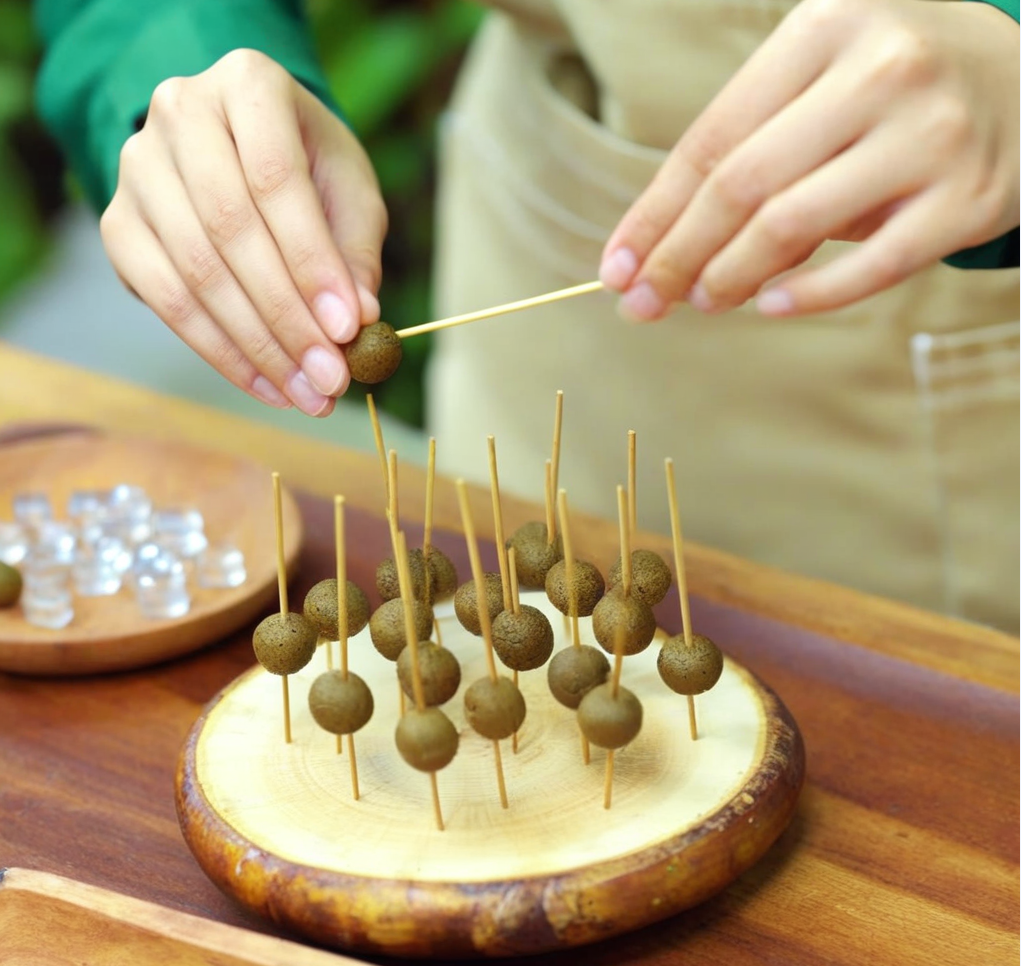
Wearable serenity - healing TCM incense bead jewelry based on Daoist tradition
Share
Whispers of Ancient Wellness: The Art of Ruyiii Incense Bead Jewelry
In the stillness of a Daoist temple, incense curls like a question mark—ascending, seeking, bridging realms. For centuries, these fragrant threads were more than ritual; they were medicine. Daoist healers blended woods and resins into incense beads, worn to harmonize the body’s qi and treat ailments from insomnia to stagnant energy. At Ruyiii, we revive this tradition, crafting jewelry where every bead is a Traditional Chinese Medicine (TCM) formula in miniature—each ingredient a healer, each blend a symphony of wellness.
Cultural & Medicinal Foundations
- Daoist Cold-Condensation: Ruyiii’s beads avoid heat to retain raw herb potency, a method refined by Song alchemists.
- Edible Incense History: Tang texts describe monks dissolving incense beads in wine for acute ailments—though modern usage focuses on aromatic therapy.
Cultural Threads: From Monasteries to Modernity
- Daoist “Fragrant Medicine”: During the Tang dynasty, monks crafted incense beads to treat travelers’ ailments—pear for coughs, clove for indigestion. Some even dissolved beads in wine for acute relief.
- Empress Dowager Cixi’s Secret: Her jade bracelets hid musk-laced agarwood beads to cool summer heat—a trick borrowed from Daoist yang-sheng (nourishing life) practices.
- Cold Incense Alchemy: Ruyiii’s cold-condensation method dates to Song dynasty alchemists who avoided fire to preserve herbs’ “cooling” properties, perfect for formulas like Goose Pear (pear + musk) to moisten autumn dryness.
Crafting with Daoist Intent
Each bead is a meditation:
- Grinding at Dawn: Ingredients are pulverized when yin energy peaks, preserving color and qi.
- Kneading 100 Times: Resins and botanic mixtures are folded like dough, a practice mirroring Daoist neidan (internal elixir) cultivation.
- Moonlit Curing: Beads rest under moonlight to absorb taiyin (lunar essence), enhancing their yin-nourishing effects.
The result? Jewelry that feels like a pulse of ancient forests and apothecary wisdom.
The Alchemy of Ingredients: Nature’s Pharmacy
Our formulas are rooted in 1,800-year-old TCM texts, where herbs and resins act as “ministers,” “assistants,” and “messengers” to restore balance.
1. Listen & Contemplate
Rosewood, Orange Peel, Sweet Cedar, Neem Flower
- Rosewood: Regulates qi stagnation, eases chest tightness.
- Orange Peel: Resolves phlegm, aids digestion.
-
Neem Flower: Clears heat-toxin (inflammation, skin irritations).
Combined Effect:
“Revitalize vital energy and uplift from fatigue”—a qi-boosting blend that dispels dampness while awakening the spleen.
Cultural Note: Ming scholars wore similar beads to combat mental exhaustion during imperial exams.
2. Agarrattan
Agarwood, Benzoin, Camphor, Orchid
- Camphor: Dispels wind-damp (joint pain, headaches).
-
Benzoin: Dissolves phlegm, soothes coughs.
Combined Effect:
“Diffuse anxious thoughts for greater inner stillness”—cools liver fire and anchors qi, ideal for modern stress.
Cultural Note: Song alchemists used cold-condensed camphor for summer-heat relief.
3. Goose Pear
Agarwood, Synthetic Musk, Goods Pear
- Pear: Moistens lung dryness (chronic coughs).
-
Musk: Historically revived consciousness in fainting spells.
Combined Effect:
“Drift into restorative, undisturbed slumber”—nourishes yin and calms the mind, echoing Tang dynasty sleep remedies.
4. Dream Fairy
Lavender, Agarwood, Angelica, Benzoin, Synthetic Musk
- Lavender: Clears heart fire (restlessness, palpitations).
-
Angelica: Expels wind-cold (sinus congestion).
Combined Effect:
“Cultivate an aura of profound relaxation”—sedates hyperactivity while grounding qi.
Cultural Note: Qing nobility tucked lavender sachets into pillows for insomnia relief.
5. Osmanthus
Osmanthus, Sandalwood, Agarwood, Camphor, Costus Root
- Osmanthus: Regulates qi stagnation in the liver (mood swings).
-
Costus Root: Warms the stomach (bloating, indigestion).
Combined Effect:
“Natural respiratory tonic to breathe easier”—clears lung phlegm and strengthens spleen qi.
Cultural Note: Daoist monks burned osmanthus during autumn equinox rituals to purify air.
6. Tetrad Unity
Agarwood, Sandalwood, Synthetic Musk, Synthetic Ambergris
- Ambergris: Traditionally used to “open orifices” (mental clarity).
-
Sandalwood: Calms heart fire (anxiety).
Combined Effect:
“Harmonize breath and Qi for greater vitality”—balances yin-yang and stabilizes the mind.
Cultural Note: Ming physicians prescribed musk-ambergris blends for meridian blockages.
7. Jet & Ivory Ambergris
Synthetic Ambergris, Agarwood, Golden Fragrance, Synthetic Musk, Sandalwood
-
Golden Fragrance: Clears damp-heat (skin eruptions).
Combined Effect:
“Anchor meditation in sublime stillness”—strengthens kidney essence and quiets mental chatter.
Cultural Note: Daoist adepts carried ambergris beads during neidan (internal alchemy) practices.
8. Spring Night
Rose, Sandalwood, Clove, Aromatic Wood, Fennel
- Rose: Soothes liver qi stagnation (stress, irritability).
- Sandalwood: Clears lung heat (chronic cough, restlessness).
-
Clove: Warms the stomach (bloating, cold digestion).
Combined Effect:
“Melts away stress and tension for rejuvenating wellbeing”—regulates liver-lung discord, harmonizing opposites: floral lightness grounded by earthy spice.
9. Xuan He Imperial
Agarwood, Sandalwood, Golden Face, Backshade Grass, Cinnabar
- Agarwood: Descends rebellious qi (nausea, asthma).
- Golden Face: Clears heat-toxin (inflammation, skin irritations).
-
Cinnabar: Traditionally used to quiet the spirit (anxiety, insomnia).
Combined Effect:
“Tranquils the mind while invigorating cognitive focus”—clears heart fire while anchoring qi, mirroring Daoist clarity practices.
10. Lady Blossom
Agarwood, Sandalwood, Frankincense, Benzoin, Rose
- Frankincense: Invigorates blood (stiffness, menstrual cramps).
-
Benzoin: Dissolves phlegm (congestion, sluggishness).
Combined Effect:
“Nurtures a calm, composed mindset”—moves blood and transforms phlegm, ideal for stress manifesting as tension or fog.
11. Jasmine Oolong
Oolong Tea, Benzoin, Clove, Jasmine, Sandalwood
- Oolong Tea: Resolves food stagnation (bloating).
-
Jasmine: Soothes liver qi (irritability).
Combined Effect:
“Elevate mindfulness and concentration”—awakens spleen qi and the mind, inspired by Song tea ceremonies.
Discover Ruyiii's incense bead jewelry collections and experience the incense haven now. 💫
Disclaimer: Ruyiii’s jewelry is inspired by Traditional Chinese Medicine principles and historical practices. These statements have not been evaluated by modern medical authorities. Our products are not intended to diagnose, treat, or prevent disease.
